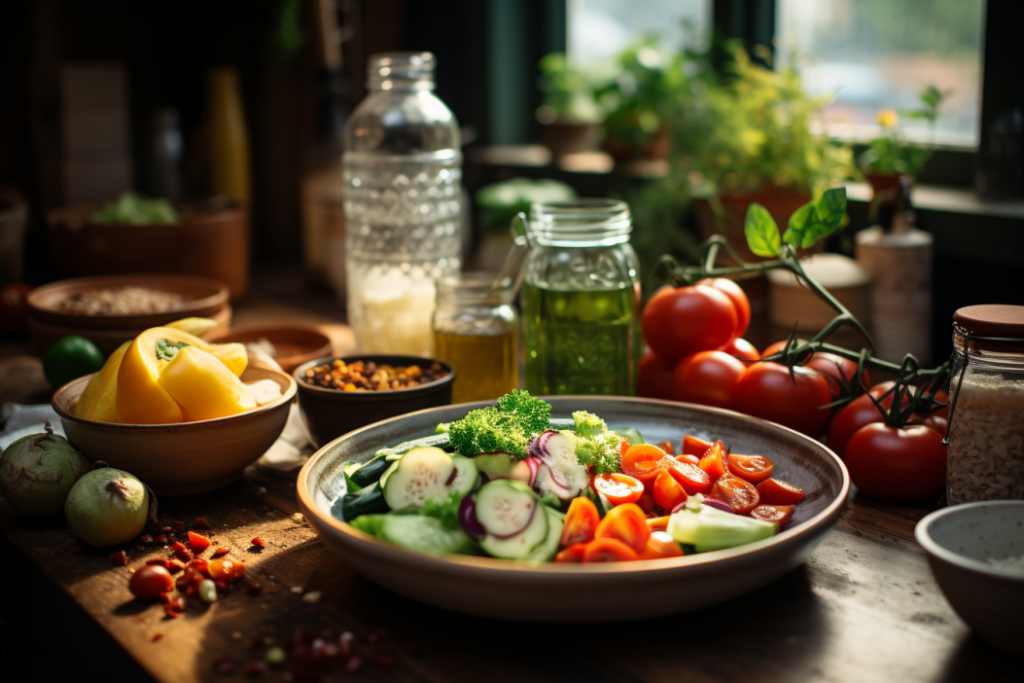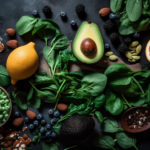Table of Contents
Smart Choices: Maximizing Nutrition Without Breaking the Bank
Hey there, foodie friends!
Are you constantly fighting the battle of maintaining a wholesome diet without drilling a hole in your wallet? Or wondering how in the world you can balance healthy eating & living without sacrificing every penny? Well, the struggle ends here! Presenting our ultimate guide – ‘Healthy Eating on a Budget.’
A myth we’re gonna bust right from the get-go – Healthy eating DOES NOT mean expensive eating. There’s a good reason grandma always swore by home cooking and fresh produce! This guide aims to help you sift through the fancy health food labels and cut down your expenses without compromising on taste or nutrition.
We don’t believe in spending half our paycheck on a tiny carton of superfood smoothie or that fancy chia seed pudding. Instead, we’re all about getting back to basics, and making smart choices like buying whole foods, finding cost-effective recipes and meal planning.
‘Healthy Eating on a Budget’ is your toolbox full of tips and tricks to boost your health, save your money, and make each meal an affordable feast. So, tighten your apron, grab your shopping list, and let’s get cooking!
Stay tuned for a pocket-friendly culinary adventure. Let’s prove together that the journey to health doesn’t have to be expensive! It’s time to smash the myth and make delicious, nutritious meals without busting your budget. Ready to dive in?
Let’s get munching, without crunching those pennies!
Understanding the Real Cost of Healthy Eating
Hey, budget-conscious food lovers! Let’s break down something that’s often misunderstood – the real cost of healthy eating.
Embrace Whole Foods
First things first, a healthy diet doesn’t have to be full of pricey specialty goods or exotic ‘superfoods’. The true heroes of healthy eating are your everyday fruits, veggies, whole grains, lean proteins, and legumes. They’re stuffed with all the vitamins, minerals, and fiber you need to keep your body running smoothly, without racking up a hefty grocery bill.
Plan & Prep Like a Pro
Another vital aspect to consider is meal planning and prepping. It’s not just for the super-organized, Pinterest-perfect folks, promise! A little forethought into your weekly meals helps you make the most of your grocery haul, reduce waste, and save money. Sounds like a win, no?
Let Go of the Packaging
Pre-packaged and convenience foods are almost always more expensive than their homemade counterparts. Sure, they save you time, but you’re paying for that convenience—literally. A little meal prep can go a long way to save you big bucks and cut down on harmful preservatives often found in ready-to-eat meals.
Learn to Love Leftovers
Ever find yourself throwing away spoiled leftover food, a week after you cooked it? It’s money down the drain! Instead, try incorporating ‘leftover nights’ into your weekly dinner plans. It’s good for your wallet and reduces food waste. Double win!
^Kick ^the ^Junk ^Food ^Bucket
What about those end-of-aisle temptations – cookies, chips & sodas? Well, they are nothing but empty calories that are eating away your budget and health! Swapping these with fresh produce, water, or homemade treats will reward both your wellness and your wallet.
Remember, healthy eating isn’t about fancy ingredients or Instagram-worthy meals; it’s about discovering the value in fresh, wholesome food. It’s viewing cooking as an adventure, not a chore. Staying healthy doesn’t mean breaking the bank, it means making smarter choices and understanding where your money is best spent.
So, stick around, dear reader. We have so much more to share to help you dive deep into the world of affordable, delicious, healthy eating. Stay with us!
Practical Tips for Grocery Shopping on a Budget
Hello all! It’s time to tackle one of our favorite topics – grocery shopping! But we’re taking a different twist this time, focusing on how to master the art of budget grocery shopping.
Stick to Your List
You know what they say, fail to plan & plan to fail. So, always start your grocery trip with a list. It takes the “grazing” aspect out of shopping and keeps your focus sharp on things you actually need.
Keep Your Gut in Check
Here’s a tip that might surprise you – Never shop on an empty stomach! It’s proven that people buy more food (especially junk food) when they shop hungry. So grab a snack before you head to the store.
Shop Seasonal
Literally enjoy the fruits (and veggies) of the season! Seasonal produce isn’t just tastier; it’s also less pricey because of the abundance. So load up on those sweet summer berries or hearty winter squash depending on the time of year.
Store Brands for the win
Don’t cover your eyes to store brands! They’re usually just as good as name-brand counterparts but at a fraction of the price. We promise, your tastebuds won’t notice the difference, but your wallet certainly will.
The Magic of Bulk-Buying
Bulk buying is your friend for non-perishable items – think grains, lentils, or frozen foods. These items don’t spoil, but they do save you an extra trip to the grocery store!
Sales are Saviors
Yep, when it comes to budget shopping, embracing sales, deals, and coupons is a smart strategy. Just make sure you’re buying things you actually need, not just because they’re on sale.
Remember, building your cart is like building a house; every choice counts. It takes a little know-how, a bit of time, and yes, a good list! The goal, though, is not to be frugal but to make informed, wise decisions that fit your budget and health.
So, let’s raise a cart to savvy, smart shopping! Continue your journey with us further into this guide. Up next, we will walk you through choosing affordable superfoods that pack a healthy, antioxidant punch on a shoestring budget. Stay tuned!
Affordable Superfoods: Nutrient-Rich Choices That Won’t Break the Bank
Hello, hello, fellow health junkies! Now, who said superfoods have to be super expensive? In this section, we’re diving into those nutritious gems that pack a healthful punch without punching a hole in your pocket.
Tiny but Mighty: Lentils & Chickpeas
Legumes, especially lentils and chickpeas, are underrated superheroes in the world of affordable health food. They’re packed full of protein, fiber, and minerals. Plus, a bag doesn’t cost much and can stretch across many meals!
Spinach – The Green Machine
Talk about getting a bang for your buck! Spinach is loaded with iron, calcium, and plenty of other essential micronutrients. Best of all? It’s super cheap, easy to cook, and can be added to almost anything.
Eggs – No Yolk, They’re Superb!
High-quality protein, a wealth of vitamins & minerals, all wrapped up in their own natural packaging. Eggs are an excellent, economical source of nutrition. Whether scrambled, boiled, or whisked into a frittata, they’re a steal!
Apples & Bananas – Fruitful Delights
No need to hunt for exotic fruits when these everyday favorites are brimming with good-for-you nutrients! They’re tasty, convenient, and perfect for on-the-go snacks or as an addition to meals.
Whole Grains – Health in a Bowl
Oats, brown rice, buckwheat. These grains are your ticket to fullness and health. They’re high in fiber and come with benefits like improved digestion and better blood sugar control. Plus, buying in bulk can add to the savings!
Peanut Butter: Cheap, Nutty Goodness
High in protein, packed with healthy fats, and undeniably delicious – peanut butter is a great budget-friendly superfood. Just stick with the natural versions to avoid added sugars and unhealthy oils.
Superfoods don’t have to be pricey to be effective. The simplest foods often carry the most nutrition and come with the added benefit of being extremely affordable. So, the next time you hit the grocery store, don’t forget to toss these nutritious, money-saving foods into your basket!
Ready for more tips on eating healthy without hurting your pocketbook? Stick around because, up next, we’re exploring all there is to know about meal planning for health and savings. Let the yummy, budget-friendly adventure continue!
Meal Planning 101: Decrease Waste, Increase Savings
Hey there, savings enthusiasts! Let’s get into the nuts and bolts of meal planning— a game-changer when it comes to eating healthy while keeping the moolah in check.
Mapping Out Your Meals
At first glance, meal planning might seem tedious but trust us, it’s worth it! Jotting down meals for the week helps you know exactly what to buy, which cuts down impulse purchases and reduces food waste, saving your greens—both kinds!
Batch Cooking and Freezing for Later
What’s better than a home-cooked meal? Multiple meals, prepped in one go! Batch cooking and freezing means you’ll always have healthy meals ready to heat and eat. It’s a great way to safeguard your budget, time, and waistline.
The Marvel of Leftovers
Cook once, eat twice! Or thrice! Transforming leftovers into a new meal not only slashes cooking time but also saves money. Like repurposing grilled chicken from dinner into next day’s salad topper. Magic, isn’t it?
Flexible is Fun
Good meal planning is flexible. For example, prepping versatile ingredients at the beginning of the week—roast veggies, bake chicken, cook rice—gives you the base for different meals. Mix and match to your liking!
Check the Calendar
Plan according to your week’s schedule. Busy days call for quick meals or leftovers. Keep this in mind and you’ll never find yourself ordering expensive, unhealthy takeout!
Embrace the Sales
Does your store have chicken on sale this week? It’s chicken meal week then! Incorporating sales into your meal plan is another way to squeeze those bucks.
Bottom line? Meal planning is all about strategic eating. It’s a sure-shot way to avoid splurging on pricey, last-minute meals or wasting unused foods. It might require some work upfront, but remember, every minute spent planning is a dollar saved!
Phew! Now that we’ve sorted meal planning, are you ready to learn how a little extra time can save you some serious money in the kitchen? Then stay tuned, because up next, we’re heading for quick, healthy meals for those too-busy-to-cook days. Let’s keep the savings going, shall we?
Money: Quick, Healthy Meals for Busy Bee
Time vs. Money: Quick, Healthy Meals for Busy Bees
Hey busy bees, always on the run with no time to cook? We feel you! That’s why this section is all about quick yet nutritious meals that save both time and money. Read on to see how!
Stir-Fries are Your Besties
Stir-fries are the quickest fix for a balanced meal. Toss in whatever veggies you have, add some protein, drizzle with a little olive oil and your favorite spices – voila! Dinner’s ready in minutes, not hours.
One-Pot Wonders
A single pot can give you wonders. One-pot meals like soups, chili, or stews make a well-rounded meal with minimal cleanup. They’re also well suited for batch cooking and meal prepping. Double win!
Breakfast for Dinner – Why Not?
Who said eggs are just for breakfast? An omelette packed with veggies is a quick, nutritious, and budget-friendly option for dinner too.
Sandwiches & Wraps – Not Just for Lunch
Let’s break the stereotype! Substantial sandwiches and wraps with layers of lean protein, loads of vegetables and a healthy spread could make a filling, quick dinner. Switch for whole grain bread for an added fiber boost!
Salads that Satisfy
Nope, salads don’t have to be boring. A satisfying salad is all about balance – a good bunch of leafy greens, a portion of protein (hard-boiled eggs, chicken, or beans), a dose of healthy fats (nuts, seeds, avocado), and a rainbow of veggies. Ready within 10 minutes and full of flavors!
Master the Microwave
Your microwave is a time-saving treasure! Steam veggies, poach chicken, or heat up leftovers – the options are endless. A microwavable meal doesn’t mean unhealthy when you’re in control of the ingredients.
The takeaway? Quick meals can be healthy, and healthy meals can be quick! So, the next time you’re caught in the work vs. cook tug-of-war, remember these quick hacks to keep you on budget and on track with your wellness goals.
Stick around as we have so much more to share! Next, we will uncover the art of buying in bulk and learn about the items you should always stock up on. Shall we continue? You bet!
Buy in Bulk and Save: The Items You Should Always Stock Up On
Hey budget-savvy buddies! Ready to get more for your money? Meet your new best friend—bulk buying! It’s all about grabbing more, for less. Let’s explore those top items to stockpile without toppling your budget.
Whole Grains: An Absolute Essential
These nutritional powerhouses—brown rice, quinoa, oats—make an excellent base for meals. Buy them in bulk, store them right, and they’ll last for months. Plus, they’re perfect for batch cooking and meal prep.
Canned Goods: Your Pantry Pals
Canned beans, tomatoes, tuna—they’re all great to stockpile when you find a deal. They have a long shelf-life and can be used in varied recipes. Just remember to choose low-sodium varieties whenever possible.
Frozen Produce: For Off-Season Times
While fresh is best, frozen fruits and vegetables are a close second. They’re picked at peak ripeness and frozen, packing in the nutrients. They’re perfect to have on hand when fresh produce isn’t in season or it’s just more convenient.
Spices: Flavor on a Dime
Buying spices in bulk can be significantly cheaper than small jars. Go for the ones you use daily like black pepper, cumin, or chili flakes. Remember, good food is well-seasoned food!
Healthy Oils: Cook InStyle
Healthy oils like extra virgin olive oil or coconut oil are worth nabbing in large quantities when there’s a bargain. They’re kitchen staples that don’t spoil quickly if stored properly.
Nuts & Seeds: Tiny Treats
If you’re a fan of these crunchy snacks or salad toppers, bulk buying is your best bet. Store nuts and seeds in an airtight container in the fridge, and they’ll stay fresh and tasty for months.
Keep in mind; bulk buying only saves money if you utilize what you buy. It’s knowing what you use often and taking advantage of lower per-unit prices.
So now that you are packing some serious bulk buying knowledge, are you ready to uncover the secrets behind understanding and choosing healthier and cheaper choices when eating out? Stay right where you are, because we have tons more to share! Onwards, we go!
Eating Out and Staying In Control: Making Healthier, Cheaper Choices
Hey folks! We all love the occasional dine-out or takeout, don’t we? But they can be pricy, as well as calorie-dense. Fret not. Let’s navigate eating out and keeping it affordable and healthy!
Order Smart
Opt for dishes grilled, baked, or steamed versus fried or sautéed. Loaded with veggies? Even better! And remember, portion sizes at restaurants are often oversized, so consider sharing an entrée or saving half for later.
Skip the Extras
Extras like drinks, appetizers, and desserts rapidly upsize your bill, and your calorie intake. Stick to water, neglect the unnecessary extras, and if you fancy a dessert—share it!
Make Lunch Your Dine-Out Meal
Lunch menus often offer similar dishes as dinner but at a reduced price. So, consider making your main meal of the day lunch. A mid-day meal out can be just as delightful and lighter on the wallet.
Take Advantage of Deals
Many restaurants run specials on certain days of the week. Check out restaurants’ deal days or early-bird specials to enjoy your favorite meal at a lower price.
Don’t Overlook Small Bites
Appetizer portions or tapas-style dishes can be cheaper and closer to an actual serving size than many entrées. Have a combo of these smaller plates for a variety of flavors without a hefty price tag.
Substitute Wisely
Substituting your sides with healthier options like extra veggies instead of french fries not only goes easy on your waistline but most often doesn’t cost extra.
Remember, eating out doesn’t have to be a budget-breaker or a diet disaster. It’s all about making smart choices. You can enjoy your meal, remain mindful of your health goals, and stay within your budget.
Ready for more? Next, we’ve got tips and tricks for using mobile apps as your secret weapon to save money while maintaining a healthy diet, both at home and while eating out. So, stay tuned and keep the thriftiness going!
Useful Apps for Smart Shopper: Save on Groceries & Plan Your Meals
Useful Apps for Smart Shoppers: Save on Groceries & Plan Your Meals
Hey there, tech-savvy savers! Welcome to the digital age of grocery shopping and meal planning. Here’s a quick rundown of handy apps that keep your pantry full and your wallet happy. Let’s get into it!
Discount Domination with Ibotta
Ibotta makes saving money on groceries a breeze. Scan your receipts, get cash back from various retailers—it’s that simple! Earning while eating—now that’s a tasty deal!
Meal Planning Marvels like Mealime
Need help with meal planning? Meet Mealime! This app helps you create personalized meal plans based on your diet preference, allergies, and more. Plus, the in-app grocery list ensures you buy what you need, no more, no less.
Digitize Your Shopping List with AnyList
AnyList lets you create and share shopping lists, making it super easy to stay organized. Can’t forget that can of tomatoes when it’s right there on your phone!
Local Bounty with Seasonal Food Guide
The best way to save money is to buy seasonal. Seasonal Food Guide lets you know what’s in season in your area so you can plan meals accordingly. Cheaper, fresher—a win-win!
Coupon Savings with SnipSnap
Physical coupons—so last era! SnipSnap lets you take pictures of printed coupons, and it converts them into digital format. No more forgetting or losing coupons.
Nutrition Tracking with MyFitnessPal
Making sure you’re getting the most nutrition for your buck is crucial. With MyFitnessPal, you can track your calories, macros, and nutrients. After all, what’s the point of saving money if you’re not fueling your body right?
Remember, technology can be your best friend when it comes to saving time, effort, and money. So, why not make the most of these apps and give your budget a boost?
Up next, we will share some healthy, flavorful, and easy-on-the-pocket recipes. So, don’t go anywhere! Our amazing journey of ‘Healthy Eating on a Budget’ is far from over. Stick with us, buddies. We’re in this together!
Money-Saving Recipes for Healthy, Tasty Meals
Hey there, economical epicures! Craving for freshly-cooked, nutritious meals that don’t leave your wallets skinny? Look no further. Here are a few delicious, cost-effective recipes to try!
BBQ Chickpea Wraps
Say hello to an ingenious, money-smart recipe. This wrap is packed with flavorful BBQ chickpeas, hearty veggies, and wrapped in a wholegrain tortilla. It’s protein-rich, full of fiber and ready in a jiffy. Perfect for lunch or dinner!
Easy Veggie-Packed Omelette
A protein-packed, wholesome dish that’s light on the pocket and heavy on nutrition. You need eggs, a splash of milk, colorful veggies, and some cheese if you fancy! Enjoy this fuss-free, filling meal any time of the day!
Spicy Lentil Soup
Here’s a dish that’s warm, comforting, and budget-friendly. This soup requires basic pantry staples like lentils, canned tomatoes, and some spices. Serve with some crusty bread or over cooked rice, and you have a complete meal!
Canned Tuna-Pasta Salad
This salad is as practical as it is tasty. All you need is cooked whole grain pasta, canned tuna, an assortment of veggies, and your favorite dressing. Light yet satisfying, and super quick to whip up!
Banana Oat Pancakes
Say yes to a nutritious, yummy breakfast without blowing your budget. These pancakes boast bananas, oats, and eggs—ingredients that are cheap and easily available. Top with fresh fruit, and you’re sorted for a healthful breakfast.
Remember, eating on a budget doesn’t mean eating boring or bland. All these recipes are proof that you can enjoy hearty, nutritious meals without spending a fortune. Making strategic ingredient choices and learning how to transform them into delicious meals is the key.
Excited for more? The journey doesn’t end here! We still have more practical tips to share with you—in particular, the secret to creating less expensive, more nutritious versions of your favorite dishes from scratch. So, stay tuned, meal maestros. The adventure continues!
Make it from Scratch: Less Expensive, More Nutritious Alternatives
Make it From Scratch: Less Expensive, More Nutritious Alternatives
Hello, budding home chefs! This part is all about embracing homemade versions of store-bought goods. Healthier, cheaper, and often tastier, let’s dive into these kitchen hacks!
Homemade Hummus: Your Versatile Companion
With chickpeas, tahini, olive oil, and spices, you can whip up a batch of hummus just to your liking. Perfect as a spread, dip, or salad dressing, and a fraction of the cost of store-bought jars.
Marinara Magic: Simple Tomato Sauce
Once you try making your own tomato sauce with fresh tomatoes, garlic, and herbs, you’ll never go back to canned. Healthier, cheaper and oh-so versatile. Pasta night, anyone?
Fresh Baked Bread: So Worth It
Baking your own bread may seem like a chore, but once you nail it down, it’s a game-changer. It’s healthier, tastier, and so fulfilling. Plus, the ingredients—flour, yeast, water, and a bit of salt—are cheap as chips!
Granola Galore: Make Your Own Mix
Nothing starts the morning off right like a bowl of granola—but store-bought versions can be pricey and loaded with sugars. Making your own granola with oats, nuts/seeds, and a sweetener gives you full control over what you’re eating and lets you save some dough!
DIY Almond Milk – An Easy Peasy Alternative
Just soak almonds, add water, and blend! Homemade almond milk is fresh, free of additives, cheap, and surprisingly simple to make. Plus, you can use the leftover almond pulp in smoothies or baked goods—no waste!
Building meals from scratch gives you complete control over what you’re putting into your body, and it’s often much cheaper than pre-packaged convenience foods. You could be saving some serious bucks with these homemade switches!
Ready for more? Our upcoming section will reveal how reading food labels can help you avoid paying extra for non-essential “healthy” add-ons and ensure truly nutritious choices. So don’t go anywhere; our money-saving, health-boosting journey continues!
Understanding Food Labels: Don’t Pay Extra for Non-Essential ‘Healthy’ Add-ons
Hello, nutrition nerds! Ever been confused by food labels and ended up paying more for something that isn’t as healthy as it seems? Let’s crack the code and start making informed purchases!
Buzzword Beware
Just because the package screams ‘organic,’ ‘natural,’ or ‘free-range,’ it doesn’t mean you should pay extra for it. Many of these labels are not regulated. Focus on ingredients, not buzzwords.
Ingredients Over Claims
A great rule of thumb: the fewer ingredients, the better. And if you can’t pronounce them, you probably don’t want to be eating them. Natural foods are always your best bet.
Sugar Sneakiness
Did you know food companies often use several types of sugar to make it appear further down on the ingredient list? Be careful. Anything ending in ‘-ose’ is a sugar variant, as are honey, agave, and anything syrup.
Serving Size Shenanigans
Sometimes, labels can ‘trick’ you with serving sizes. That ‘low calorie’ snack can quickly multiply if the actual portion size is bigger than what’s listed. Always check the serving size verses portion size.
Nutrient Naughtiness
Pay attention to the nutrient content per serving as well—especially sodium, sugar, and saturated fats—and compare it with the daily values.
Learn to Decode Dietary Labels
Know how to decode labels like “low calorie,” “reduced fat,” or “sugar-free.” Sure, a product might be low in fat, but is it high in sugar? Learning the lingo can save you money and help you make truly healthy choices.
Remember, not all health food is created equal. Understanding food labels can help you make healthier, cheaper, and more informed choices without getting swayed by marketing gimmicks.
Ready for more insights? Up next, we are exploring how owning a small garden can help you save money and ensure you have fresh ingredients on hand at all times. So, stick around, we’re just getting to the exciting part!
Grow Your Own: Simple Steps to an At-Home Vegetable Garden
Hey there, budding gardeners! Ready to get your hands dirty with an affordable way to ensure you’ve always got fresh, healthy produce on hand? Let’s dive into the basics of setting up your own vegetable garden!
Start Small, Think Big
Never gardened before? No worries! Start by planting a few herbs in pots—basil, parsley, or cilantro are all excellent choices. They’re easy to grow, and you’re less likely to buy more than you need and let it go to waste!
Choose High-Yield Plants
Some plants give more bang for your buck. Vegetables like tomatoes, cucumbers, or zucchini grow abundantly and consistently, providing plenty to eat and share!
Compost for Cultivation
Save money on fertilizers by making your own compost. Use vegetable scraps, coffee grounds, or eggshells to create nutrient-rich food for your plants. It’s a win-win—reducing kitchen waste and growing your garden!
Go for Seasonal Seeds
Choose seeds based on the season – you’ll have healthier plants that yield more. Plus, seasonal vegetables typically require less maintenance and are more resistant to pests and diseases.
Water Wisely
Efficient watering saves money and helps plants grow. The trick is watering deep and less often. So the water reaches the roots where it’s most needed, and there’s less waste due to evaporation.
Growing your own vegetables isn’t just about saving money, although that’s a great perk. It’s about knowing where your food comes from, reducing your carbon footprint, and reaping the benefits of a hobby that’s good for your mind and body.
Growing a garden is a natural next step to greater control over your budget and health. And as we progress towards the conclusion of this guide, we want to share the ultimate grocery list to maximize health without straining your budget. Are you ready? We bet you are! Let’s push on!
The Ultimate Money-Saving Shopping List for Healthy Eating
Hey thrifty food lovers! Ready to translate all that you’ve learned into a tangible, sensible shopping list? Here’s the ultimate guide to fill your pantry without emptying your wallet.
Produce
Prioritize seasonal vegetables and fruits—they’re cheaper and tastier. Also, bulk buy sturdy veggies like carrots, onions, or potatoes that have a longer shelf life.
Protein
Opt for budget-friendly proteins. Canned fish, eggs, and legumes are all fantastic choices. If you eat meat, go for cheaper cuts and stretch them over several meals.
Whole Grains
Stock up on oats, brown rice, and whole grain pasta or bread. They’re versatile, filling, and affordable, especially when bought in bulk.
Dairy and Non-Dairy Alternatives
When it comes to dairy, often the plainer the product, the cheaper and healthier. Think plain yogurt, milk, or cheese blocks. For non-dairy, consider making your own almond or oat milk.
Healthy Fats
Don’t underestimate the power of healthy fats in your diet. Avocados, nuts, and seeds can be cost-effective when bought in bulk or on sale.
Herbs, Spices, and Condiments
Liven up your meals without denting your budget. Canned tomatoes, chicken broth, mustard, and vinegars, along with a basic selection of herbs and spices, should get you through countless recipes.
Remember, a well-stocked pantry is the first step to eating healthfully and economically. Often, how you shop and what you prioritize can be just as important as what you’re cooking.
Coming up, we’ll tie everything together and give you a roadmap on maintaining a healthy diet on a budget. You’ve made it far, and we’re excited to guide you through the last leg of the healthy eating journey. Keep going, savvy shopper; we’re nearing the finish line!
Conclusion
Alright, folks, here we are at the end of our money-smart, health-conscious journey! Our trip through “Healthy Eating on a Budget: The Ultimate Guide” has shown us that munching nutritiously while minding our money is totally doable!
We’ve busted some myths regarding the cost of a healthy diet and learned many savvy strategies—from understanding the real cost of healthy eating to decoding food labels, from embracing meal planning to making dishes from scratch. We’ve explored the art of buying in bulk, finding deals, knowing when and where to spend, and—let’s not forget—the fun of a mini vegetable garden!
Through this guide, we’ve discovered that saving money doesn’t mean skimping on flavor or nutrition. Instead, it often means more wholesome meals packed with fresh veggies, whole grains, and lean proteins. So, remember, cheap eats don’t have to be cheap tasting!
We hope this guide steers you towards a healthier, cost-effective lifestyle free from the common misconception that ‘healthy equals expensive.’ The journey to well-being doesn’t have to cost you an arm and a leg—just a little planning, smart shopping, and a love for good food.
Happy, healthy eating on a budget, everyone! Cheers to a lifestyle that’s as nourishing for your body as it is for your bank balance. You’ve got this!









